
Why are most proteins only stable to the tune of 5-15 kcal/mol? Probably
for the same reason that we don't drive around in tanks. The evolutionary
pressure is for a protein (or a car) to be strong enough to perform its
function, but no stronger. If a protein accumulates a stabilizing mutation
(which has no other effects), without evolutionary pressure to keep it stable,
it will likely soon accumulate another destabilizing mutation. However,
if this protein accumulates a destabilizing mutation which compromises its
ability to function, natural selection will rapidly remove it. One example
suggestive of this is on the mutation of the barnase to a close homolog
called binase (Serrano et al,
1993). These proteins have 17 differences out of 110 amino-acids, and
highly superimposable structures.

Each individual mutation was made from barnase to binase and each of these point mutations only affected stability by between +1.1 and -1.1 kcal/mol. This suggests that neutral drift from one protein to another has kept stability remarkably constant. This is consistent with the hypothesis that destabilizing mutations are selected against by reversion or compensation, and stabilizing mutations are not kept, as they are not necessary for function. It is interesting to note that combination of six stabilizing mutations led to a protein that is 3.3 kcal/mol more stable than the wild-type. Thus, there appears in this case to be no a priori reason that the protein could not attain increased stability.
An alternative explanation for the narrow window of stability observed in the binase / barnase case is that activity and stability are inversely related, that in order for an enzyme to be an efficient catalyst, it must be flexible, which leads to a decrease in stability. This view has been proposed based on the observation that enzymes from hyper-thermophilic organisms have low activity at mesophilic temperatures (e.g. Hensel, 1993). I believe that this explanation is wrong. The evolutionary pressure on a protein from a hyper-thermophile is to be both as stable as necessary, and as active as necessary. If a hyper-thermophilic protein is as active at high temperature as a mesophilic protein is at low temperature (i.e. sufficient for the organism) simple thermodynamics tells us that it will function poorly at low temperature. The principles of chemistry would suggest that, except where large loop movements are necessary for catalysis, the only parts of an enzyme that need flexibility are those side chains and groups that need to move during transition state development. Further, all the work that I am aware of in which mesophilic proteins have been stabilized by site directed mutagenesis (including those described in this dissertation), have not had any systematic effect on activity, in most cases being neutral.
![]() Chemical Degradation
Chemical Degradation ![]() Conclusion
Conclusion![]() Beginning
Beginning